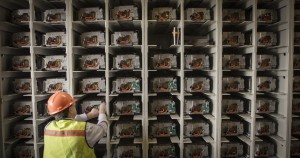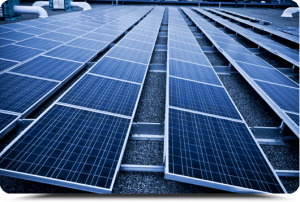With more solar and wind power on the grid, we’ll need lots of energy storage to soak up any surplus power for use during windless nights or cloudy days. Batteries are getting a lot of attention, but “gravity trains” may be an option as well.
Edgylabs.com profiled a company I’ve discussed before called Advanced Rail Energy Storage (ARES):
The ARES system is basically a series of heavy concrete blocks on a railway. The excess power from the grid pushes those blocks up an incline. When demand puts a strain on the grid, these blocks are released and go back down the incline. Through the magic of regenerative braking, that kinetic energy gets converted into an extra jolt of electrical current for the grid.
Each of the trains weighs about 300 tons, and they work best on an incline grade of 7.2%. As each train moves down the incline, they pump about 50MW of power into the grid.
The obvious limitations are the need for space and inclines. But it could be a good solution for some of the hilly or mountainous regions in western states like California. I’m glad to see the company is still moving forward with its technology, as we’ll need all sort of energy innovation to solve the storage needs.
Meanwhile, you can watch this Bloomberg news segment on the company:
Last week I blogged about the potential environmental and governance harms from clean technology mineral extraction. But what about one specific technology, the lithium ion batteries powering the burgeoning electric vehicle market?
Alex Tilley and David Manley of Natural Resource Governance Institute (NRGI) discussed the potential boom in lithium mining in specific parts of the globe:
[I]dentified lithium resources are concentrated in salt flats in Argentina, Bolivia and Chile. If the world shifts to lithium-ion batteries to power vehicles and electricity consumption, South America will become a globally strategic region for energy. And if governed well, this industry could be transformative for these countries’ economies.
Fortunately many of these lithium-rich countries have decent standards and processes for mineral extraction, although we’ll need to be vigilant to monitor impacts.
The story is more concerning though for cobalt, also an important metal for EV batteries. Cobalt is a byproduct of copper and nickel mining, and a typical EV contains about 33 pounds of cobalt. Until recently, there were often surplus cobalt supplies, as it was used mostly for steel production. But its ability to conduct electricity so efficiently has made it critical for rechargeable batteries like in EVs and therefore more in demand.
The problem is the location of the supply. Thomas Wilson in Bloomberg News tackled cobalt mining in a recent piece, noting that the relatively rare metal is found mostly in the Democratic Republic of Congo, “a country in the African tropics where there has never been a peaceful transition of power and child labor is still used in parts of the mining industry”:
The country formerly known as Zaire — which hosted boxers Muhammad Ali and George Foreman for their 1974 heavyweight title bout dubbed the “Rumble in the Jungle” — supplies 63 percent of the world’s cobalt. Congo’s market share may jump to 73 percent by 2025 as producers like Glencore Plc expand mines, according to Wood Mackenzie Ltd. By 2030, global demand could be 47 times more than it was last year, Bloomberg New Energy Finance estimates.
With demand growing, mining companies including Glencore, Eurasian Natural Resources Corp. and China Molybdenum Co. are pouring more money into Congo. With cobalt prices rising, that government is looking for ways to increase its control of the supply as well as the profits. It’s also creating supply disruptions, as in a recent incident in which the government blocked copper and cobalt exports by the China-Congo joint-venture Sicomines in a dispute over local refining.
Worse, the cobalt mining may entail significant human rights violations. Amnesty International alleges that some “informal” mines may rely on child labor.
Corporations are responding to some of the public pressure around situations like in Congo to address the human rights and environmental implications of the battery supply chain. Apple and Samsung in particular were forced to more fully vet their suppliers. But these companies don’t always know where their cobalt comes from. Ultimately, more than half of the world’s supply of refined cobalt in rechargeable batteries comes from China, which in turn gets 90 percent of its cobalt from Congo.
Without more public pressure and international guidelines and cooperation, we lack guarantees that resource-rich countries will meet decent environmental and governance standards. Not only will residents of these areas be at risk, the supplies for electric vehicles may be held hostage to unstable, corrupt regimes. We’ve been down that road before with oil, and we should avoid repeating it in the coming age of electric vehicles.
It’s a recurring knock on clean technologies like solar PV and wind turbines. Critics like to argue that the metals and mineral extraction to make them entail exactly the kind of pollution – and sometimes political conflicts – that clean tech advocates hope to displace in the current fossil fuel supply chain.
We should be clear that we’re starting from a terrible baseline: the geopolitical negatives and pollution from the current regime of oil extraction, coal mining, and natural gas infrastructure dwarfs the likely risks and environmental footprint of producing most clean technology like solar PV and wind turbines.
But at the same time, it’s an area of legitimate concern and one that probably should be addressed at this relatively early stage in clean tech deployment, when advocates of better governance and pollution controls have potentially more leverage over the source countries and states.
Alex Tilley and David Manley of Natural Resource Governance Institute (NRGI) explore the environmental and political footprint of the clean tech supply chain in a recent blog post and accompanying report. The researchers based their analysis on a World Bank report on various clean technologies and the minerals and metals needed to manufacture them, down to country-level data for the various commodities. They then ran the data against the 2017 Resource Governance Index (RGI) scoring:
[We] found that across the different minerals, on average 42 percent of reserves are in countries with “good” or “satisfactory” resource governance, 37 percent are in countries with “weak” scores (China accounts for 14 percent of this total) and a further 7 percent are in countries that score “poor.” Almost none of the reserves are in countries that are “failing” in their resource governance.
The outlook also presents some serious risks. A high average proportion of minerals reserves is found in countries with “weak” or “poor” governance and for some of the individual minerals, this proportion is much higher.
For example, 90 percent of the reserves of chromium, a mineral used in wind turbines, are in Kazakhstan and South Africa, two countries with “weak” RGI scores. Almost two-thirds of reserves of manganese, used in both wind turbines and lithium-ion batteries, are in countries that score “weak” or “poor” in the index—32 percent in South Africa, 23 percent in Ukraine, 7 percent in China, 4 percent in Gabon and 2 percent in Ghana.
The problems that could ensue from resource extraction in these “weaker” countries include worsening corruption, over-reliance on a single extractive industry, more political conflicts over resources, and local pollution of forests, rivers, and coastlines. For project developers, these impacts could result in delays and project cancellations.
The authors cite some potential solutions from a Nature article for the international community to consider:
Because avoiding disruption is so crucial for the progress of clean technologies, the group of experts writing in Nature propose a global governance approach to avert potential bottlenecks. They call for the international community to set targets for mineral production; map resources; monitor impacts; research and invest in new extractive technologies; and carry out exploration in new frontiers, from sea beds to deep in the earth’s crust. Additionally, they propose an early warning system, using data analysis to trigger alarms for impending supply, governance and environmental concerns.
The upside for the residents of these countries, if the extraction processes are sound with respect to governance and environmental impacts, is rising standards of living and potential growth of a more diversified, open and tolerant economy. The downside though is unfortunately all too possible, unless the international community and clean tech industry mobilize for coordinated policy action.
The island of Molokai in Hawaii would be a good place to start a clean energy revolution, at least in the United States. The island imports oil to burn for electricity, leading to some of the highest electricity rates in the country, not to mention significant pollution. It also has abundant sunshine and a relatively small population.
So a solar array coupled with battery energy storage could potentially save the residents a huge amount of money on their electricity bills. It could also provide them with energy security and independence in the event of fuel shortages. And of course, it could reduce emissions per capita significantly, as the model scales eventually to meet 100% of the island’s electricity needs.
A mainland company called Half Moon Ventures produced a video with Molokai-based Quazifilms to feature their solar+storage proposal for Molokai. While the project will need community and utility buy-in to move forward, this video does a nice job explaining the issues and opportunities:
As the company spokesperson says in the video, if it can work on Molokai, it can work on the other islands. And eventually, as prices decrease, this basic model can benefit communities across the country and globe.
As the world switches from petroleum fuels to lithium batteries in electric vehicles, do we need to worry about creating a new Middle East-type cartel that can once again hold the world’s energy supply hostage? The concern might have some justification, as just four countries have the largest reserves of lithium (Australia, Chile, Argentina and China). Chile, in particular, is thought to have more than 50% of known economic reserves.
The Conversation describes where battery raw materials come from, and concludes somewhat positively:
The supply of major materials for lithium batteries is not under threat any time soon, but demand is likely to open up new areas for extraction, bringing new risks.
The political situations of countries with large reserve shares and large shares in the processing of these metals can quickly become uncertain. Will countries like Bolivia allow unrestricted export of lithium? Will Democratic Republic of Congo or China restrict cobalt supply?
Environmentally, the lithium-ion battery’s future is also worrying. The production of electrode materials may become more environmentally damaging. On the other hand, the impact of the lithium supply itself is likely to improve.
Ultimately, recycling lithium should play a part in mitigating political, environmental and economic risks in the future, but high rates of lithium battery recycling are yet to be seen.
It’s always a risk once we become overly dependent on one source of energy (or in this case, energy storage) that it will lead to national security issues with foreign control over those resources.
But it’s worth noting that the U.S. has its own supply of lithium, and also that current estimates from the U.S government at least indicate an adequate worldwide supply to meet demand (although Greentech Media raises some alarm bells on this question).
Ultimately, this is a long-term potential problem that can likely be addressed with further innovation in manufacturing, battery development, and recycling and reuse of existing batteries. And it’s certainly not a reason to avoid investing in battery electrification of transportation.
But at the same time, if I was working in national security, it would be an issue to track going forward.
 Electric vehicles are good for the environment not just because they decrease petroleum fuel burning, but because the batteries in the vehicles can help support a cleaner grid. To test that concept, BMW signed up drivers of their electric i3 vehicle for a project with Pacific Gas & Electric in the Bay Area. The basic goal was to reduce demand from a fleet of vehicles at a time when the grid was constrained, by activating software in the vehicles to halt charging for up to an hour.
Electric vehicles are good for the environment not just because they decrease petroleum fuel burning, but because the batteries in the vehicles can help support a cleaner grid. To test that concept, BMW signed up drivers of their electric i3 vehicle for a project with Pacific Gas & Electric in the Bay Area. The basic goal was to reduce demand from a fleet of vehicles at a time when the grid was constrained, by activating software in the vehicles to halt charging for up to an hour.
The upside for drivers who participated? They got $1000 for signing up, plus as much as $540, depending on how many days they did not manually opt out of the program. Drivers were notified by a software app when a delay was about to happen and could use it to opt-out if needed.
In practice, that meant eight delays in charging over the 18-month pilot period for the typical driver. However, some vehicles, based on when they were plugged in and how little they opted out, had more delays. Of the 100 participating drivers, for example, three vehicles participated in over 50 events.
If it sounds like a good deal, that’s because it is. In fact, 500 drivers ended up applying for just 100 spots in the pilot. The report did not mention if the payments were cost-effective from a ratepayer standpoint (I suspect not). In other words, could that electricity have been more cheaply supplied or reduced elsewhere? But given that this was a pilot, it was important to get data and participation first.
During the 18 months (from July 2015 to December 2016), PG&E asked BMW 209 times to “provide capacity of 100 kW over an hour-long period.” This is actually a lot of times. As a point of comparison, residential “demand response” (as this kind of moderated demand is called) programs are capped at 15 events per year.
Ultimately, BMW met 90% of the events. The reason for the failings was mostly due to technical problems, which apparently got fixed as the pilot went on. And the response time to actually delay the charging once the utility sent the signal was 2.3 minutes on average, which was fine for the day-ahead market and not bad for the real-time market, which requires 4 minutes at most of delay. The lag was mostly due to communications issues that seemed to get fixed as the pilot unfolded.
Drivers seemed not to mind the delays. The most opt outs for any one event was on Thursday, October 14, 2015 at 11 PM, when three customers opted out. The majority of events had no opt-outs and only two participants opted out for more than two events over the entire pilot. Meanwhile, 95% of the drivers surveyed said that they never, or rarely, had to change driving or charging behaviors. Ultimately, 98% indicated they were satisfied with the experience.
 But there was one relatively big hitch to the findings: not enough EV drivers were plugged in at any given moment to meet the demand response events. As a result, BMW had to rely on “second-life” used electric vehicle batteries to meet almost 80% of the power requested during these events. The vehicles on average supplied the other 20% of the demand reduction.
But there was one relatively big hitch to the findings: not enough EV drivers were plugged in at any given moment to meet the demand response events. As a result, BMW had to rely on “second-life” used electric vehicle batteries to meet almost 80% of the power requested during these events. The vehicles on average supplied the other 20% of the demand reduction.
Possibly because of time-of-use rates and cheap off-peak power, many drivers did not plug in until after 9pm. As a result, these drivers simply missed any demand response events happening during the daytime or early evening. In fact, only 37% of the drivers charged at work during the day, due to the lack of availability of chargers at their place of employment.
Meanwhile, the drivers that were able to participate in the top 10%:
[A]re characterized as frequent drivers, who have regular charging patterns and are not on a [time-of-use] rate. These drivers habitually plug in and begin charging around 8 PM in the evening and typically charge for about 3 hours. Since a majority of the events were called from 8–9 PM, these vehicles were frequently called upon and able to participate.
So in the long run, more workplace charging and electricity rates that encourage demand response participation could address these challenges.
Meanwhile, the benefits to the grid look very promising. Each vehicle contributed 4.43 kw of demand response delayed usage. It may not sound like much, but assuming by 2030 the state has 1.2M electric vehicles, with 250,000 drivers enrolled in this kind of program and 17,000 participating in a demand response event:
[T]he potential load drop of a single event in 2030 is about 77.6 MW, which is enough to power approximately 58,000 homes in California. Thus, on a larger scale, a similar program has the potential to provide a significant resource.
So while more work remains to be done, this pilot project is overall very encouraging. Coupled with reforms related to boosting workplace charging and improving electricity rates (the subjects of a forthcoming report from UC Berkeley and UCLA Law), this kind of demand response could be very beneficial for the state.
And it could put a healthy dollop of cash in EV drivers’ wallets to boot.
AB405, SB146 and SB150 have officially been signed into law. Thanks #nvleg for your leadership & @TeslaMotors for hosting a great event. pic.twitter.com/t2L1DWNbnt
— Governor Sandoval (@GovSandoval) June 15, 2017
What a difference a year (or two) makes. Back in 2015, Nevada became the enemy of rooftop solar advocates when state regulators arbitrarily ended all rooftop solar incentives, including for customers who had already invested in them with an expectation of a 20-year return.
But Governor Sandoval just signed AB 405, which will officially restore those rooftop solar rates almost back to where they were, with a slow phase-out to encourage more energy storage options (see his Twitter post above).
But more legislation is on tap, as the legislature has passed some ambitious clean energy bills. Specifically, AB 206 will boost the state’s renewable energy portfolio standard to 40 percent by 2030 (by comparison, California has a 50% target for 2030). And as Greentech Media reports, the innovative part of this bill is that energy storage can count for up to 10% of the portfolio, with special privileges for geothermal energy. Let’s hope the governor signs this bill, too.
While the solar industry had a lot to do with this win, environmental groups may also have played a key electoral role. Specifically, according to E&E News (pay-walled), the League of Conservation Voters spent more than a half-million dollars on state races in Nevada last year and helped flip the statehouse, paving the way for legislation like this.
It shows how effective political dollars can be at the state level, and how important state leadership is at a time of federal retrenchment on clean energy policies.
Tesla’s tiled solar panel roof made a big splash when Elon Musk unveiled it last year (photo to the right). But the roof comes at a pretty steep price, as Bloomberg reports:
A Tesla solar roof will also lose some of the energy-generating density of a traditional panel, because the cells must be spaced farther apart to account for the edges of the tiles, BNEF’s Bromley said. Therefore, the percentage of the roof that will be covered by active solar cells will be higher, as will the total cost of the roof. All told, a traditional solar setup might be 30 percent cheaper than a Tesla roof, he said, but Tesla’s will look better and come with a lifetime warranty. “A 30 percent premium could well be acceptable.”
“It is the most affordable roof you can buy, all things considered,” said Peter Rive, co-founder of Tesla’s recently acquired SolarCity division.
Perhaps the extra cost is worth it in terms of getting a new roof and possibly not having the visual impacts of a traditional solar array (I personally don’t mind the look of traditional solar panels, but some people do, which could decrease home values I suppose). But only so many homes need a new roof at a given time, so right away the market seems limited.
There also may be technical issues with this new type of technology. I talked to a solar engineer recently who thought the tiles would have problems without having the cooling air space underneath, like with traditional mounted panels. The extra heat would supposedly hinder the lifespan and energy production value. I don’t know how to evaluate that claim or whether or not Tesla has addressed it, but it points to concerns people may have with adopting a new form of the technology.
I like the idea of Tesla combining with SolarCity to package clean energy and energy storage together with the vehicles, but the solar roof concept may have a rocky start.
We certainly need cheap renewables like solar, coupled with batteries, to clean our grid and mitigate climate change. But these technologies also hold incredible promise as economic development lifelines for remote indigenous communities.
The Guardian recently profiled a growing indigenous renewable energy alliance in Australia:
Only a handful of Indigenous communities have embarked on renewable energy projects in Australia. The Indigenous-owned and -operated company AllGrid Energy, for instance, has installed solar panels and battery storage systems to replace diesel generators in the Aboriginal communities of Ngurrara and Kurnturlpara in the Northern Territory’s Barkly Tableland. Within two months of the system being installed in May 2016, people were moving back to their homelands from Tennant Creek, the communities growing from just two permanent residents to about 40.
As these technologies become cheaper, not only will the developed world benefit, but historically disadvantaged communities across the globe will have access to clean, cheap power for their hospitals, homes and businesses.




